The
Home Page Selection
If
you require further information on any
print featured here, please contact
us.
When
a print has been sold it will be marked
as Sold.
A
growing archive of selections
from previous Home pages is featured in
the
Home
Page Selection Archive |
|
See
also :
Click
on a thumbnail (left)
to link directly with the entry for that
print, or scroll down to view all the selected
prints from the current Home
Page.
Images
are not to relative scale (see stated dimensions) and also at only modest resolution.
If you wish to view extracts of an image at higher resolution, please Contact us.
|
|
|
|
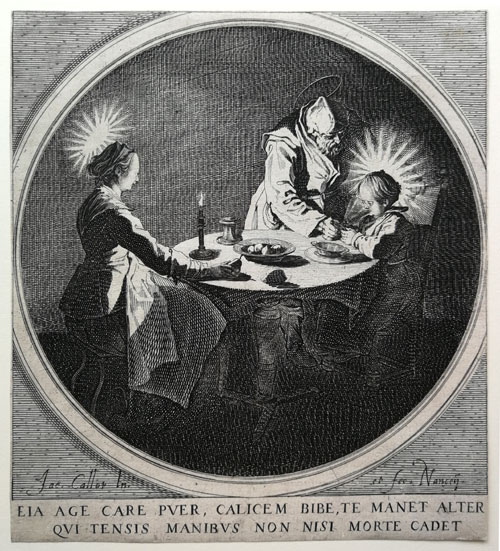
| |
JACQUES CALLOT
Nancy 1592 – 1635 Nancy
Callot went to Rome at the age of sixteen, as an apprentice to the engraver and print dealer Philippe Thomassin. After three years he moved to Florence. There, from 1611, he was employed by Cosimo de’Medici, until the death of his patron, when Callot returned to his native Lorrain in 1621.
After his return to France, Callot produced in the later 1620’s two plates which were thematically exceptional in his work, of figures sitting round a table by candlelight.
The Benediction, a rarely treated subject, elaborated from the biblical life of Christ, shows the Holy Family as a contemporary family in a tender scene with Joseph helping the young Jesus to drink from a large glass. (Joseph was only seriously venerated as a saint after 1621.)
Le Bénédicité  The Benediction The Benediction
Lieure 595 iii/iv
190 x 169 mm
Original etching, c1627-29.
The plate signed.
A good impression, though the plate beginning to show some wear, trimmed inside the platemark close to the borderline on three sides, and beneath the lettering at the foot.
Third state, before the later address of Israel Sylvestre as publisher.
£1500
The Latin couplet at the foot, translates as
Come dear Child, drain the cup;
another awaits you
which only death will let fall
from your hands.
Return to top ^ |
|
|
|
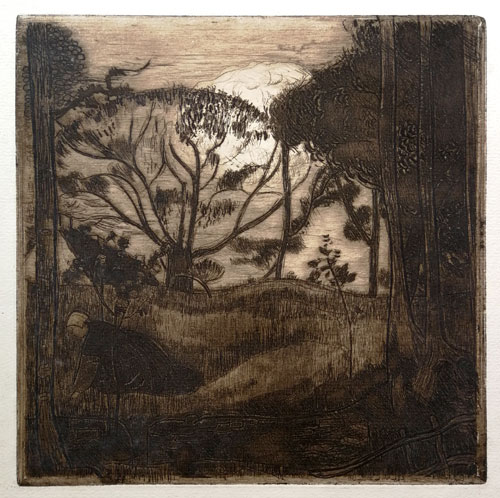 |
|
ARMAND SEGUIN
Brittany 1869 – 1903 Châteauneuf-du-Faou, Finistère
Printmaking occupied a larger place in Seguin’s work than in any of the other artists of the Pont-Aven group.
Seguin discovered Gauguin and the other Pont-Aven artists in 1889 at the exhibition at the Café Volpini in Paris.
In late 1890 Seguin took up etching and became very enthusiastic about the process.
On the 26 December he wrote to Forbes-Robinson,
Je n’ai jamais été aussi emballé avec l’eau-forte, du soir au matin et du matin du soir, je pioche … (I have never been so carried away by etching, from night to morning and from morning to night, I needle …)
and for the next two or three years devoted himself to the technique, producing about eighty plates.
Le Soir ou La Glaneuse
 Evening or the Gleaner Evening or the Gleaner
Field 68, only state
230 x 228 mm
Original etching with aquatint and roulette, 1893.
Signed in pencil and numbered.
Published 1894 by L’Estampe Originale.
Edition of 100.
Trimmed in the sheet margins and hence lacking the publisher’s blindstamp.
Printed in dark brown ink on cream laid paper.
£1250
A Breton subject.
Return to top ^ |
|
|
|
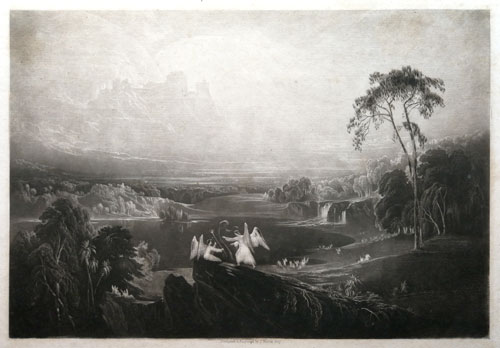 |
|
JOHN MARTIN
Hayden Bridge, Northumberland 1789 – 1854 London
Martin took up mezzotint by 1824; a painterly technique whose rich chiaroscuro was particularly suited to realising his romantic vision of landscape and dramatic themes taken largely from the Bible or from Milton.
That year the publisher Septimus Prowett commissioned twenty-four mezzotint illustrations to Milton’s Paradise Lost. While work was in progress Prowett extended his commission to a second series, of reduced size, though similar in composition. Both series were issued either as lettered proofs in editions of 50, or as unlimited lettered ‘prints’.
Martin composed the Paradise Lost mezzotints directly onto the plates and, as both the originating artist and the engraver, was paid on average over 70 guineas per plate. A remarkable figure if compared to Lupton’s 5 gns per plate for adding mezzotint to J M W Turner’s etched Liber Studiorumplates.
Heaven – the Rivers of Bliss
Campbell-Wees 47; Paradise Lost Book 11, line 78
256 x 357 mm (sheet)
192 x 283 mm (image)
Original mezzotint, 1824-25, for the initial larger series of illustrations to Milton’s
Paradise Lost.
A lettered ‘print’ published by Prowett 1825.
Printed on cream laid paper, trimmed to the platemark, with wide plate borders.
Borders with overall foxing and time-staining.
£200
Return
to top ^ |
|
|
|
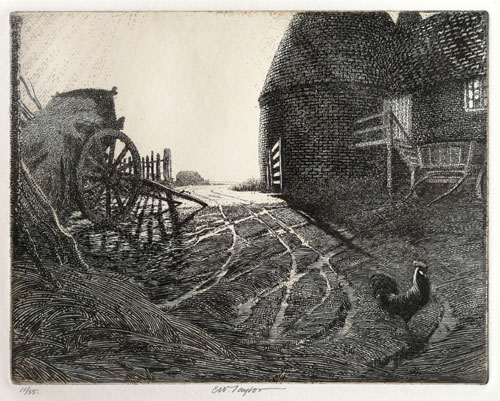 |
|
CHARLES WILLIAM TAYLOR R.E.
Wolverhampton 1875 – 1960 Findon, Sussex
Taylor worked as a commercial engraver till he was thirty, when he went to study Design at the Royal College of Art, 1905.
After graduation he had a number of teaching posts.
It was not till the early 1920’s that he took up creative printmaking.
He began with wood engraving, and was elected an Associate of the R.E. in 1922.
In 1926 Taylor also began etching.
After retiring from the Southend School of Art in 1930, Taylor settled in Sussex.
The Farm Yard or Sussex-Noon
164 x 206 mm
Original etching.
Signed in pencil and numbered 11/55.
Printed in brown-black ink on cream wove paper.
Sold
Return
to top ^ |
|
|
|
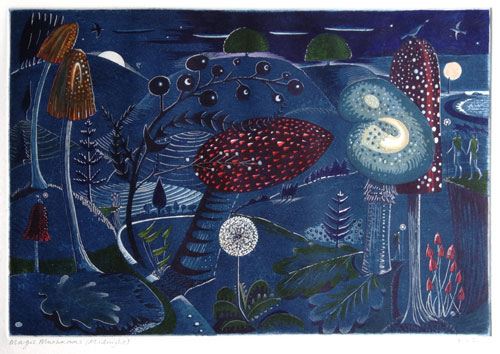 |
|
KIT BOYD
Born 1969
Boyd studied the visual arts at the University of Wales Aberystwyth 1988-91.
After graduating, work in London included nine years with the Campaign to Protect Rural England, which chimed with his artistic concerns of "our relationship with the landscape and our place in nature .".
In 2006 Boyd moved back for a couple of years to the Welsh marches to concentrate on his creative work.
In more recent years he has begun to make colour prints, individually hand painting over an etched
impression to create a one-off in that particular colour scheme.
Magic Mushrooms (Midnight)
188 x 295 mm
Original hand-painted etching and aquatint.
The plate, monogrammed, printed in blue.
Signed in pencil and entitled.
On stout wove paper.
£600
Return
to top ^ |
|
|
|
|
|
|
|